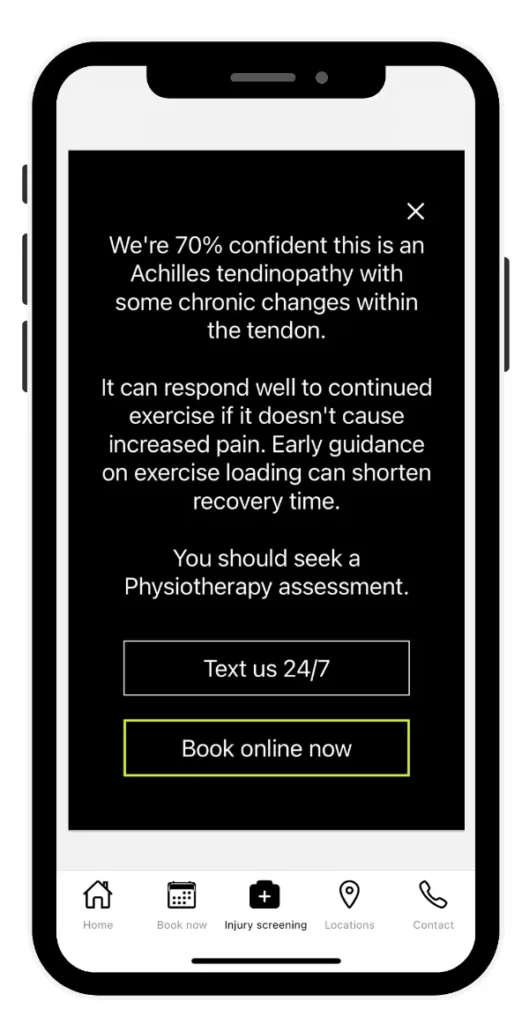Firstly, a big congrats to everyone who made it to the start line for any distance at the Sydney Marathon event in 2023. Aside from the usual challenges of distance running, this year had the added bonus of bushfire smoke during the week (from some less-than-well-timed backburning operations) and unseasonable heat into the low 30s on race day.
Those conditions mean that recovery and niggles after marathon and half marathon distances will be slightly different to a typical race.

Need a diagnosis today?
Did you know that Bioathletic has developed a custom app?
- It thinks like a Physio
- It gives you an instant provisional diagnosis and advice
- It’s completely FREE!
It’s available now in Apple app store and Google Play store
Recovery and niggles after marathon & half-marathon
The heat, low humidity and smoky conditions are likely to leave you more dehydrated than after a typical race.
Dehydration leads to more prolonged muscle soreness and just feeling flat for days afterwards. So it’s extra important to consistently rehydrate with electrolytes for 24-48 hours after the race (you can’t just guzzle 2L of Gatorade at the finish line!).
Heat and smoke will also affect your energy levels during the race, leading to a higher level of exertion and/or a slower pace. That change causes your running technique to become less efficient, which puts pressure on parts of your body that you never felt in training.
The most common areas of painful overload are:
- ITB
- Patella/front of knee
- Hips/gluteal muscles
- Lower back
- Calf muscles
The way you respond to each of these areas differs, particularly if you’d like to get running soon after the race.
ITB
ITB pain happens when the alignment of the leg isn’t maintained during your running stride. Essentially the leg isn’t well supported by muscles and twists inwards on landing, which causes increased pressure across the ITB.
If you’ve got no intention of running for 3-4 weeks after the race, ITB issues tend to disappear by the time you get back to training.
If you’d like to get running sooner, you often need to utilise additional stability (such as taping or orthotics – physio can advise on the best method of support for your biomechanics) and reduce your training loads by 50% or more to account for post-race muscle fatigue.
Interestingly, ITB pain often feels better with faster running so using interval-based sessions on your return to running is a smart play.
Patella & front of knee pain
Similar to ITB, issues around the patella are often caused by the effects of fatigue on your running technique. The difference is that patella issues can have an inflammatory component, which causes cartilage to become sensitive. It means that the injury can hang around even if you don’t return to running for several weeks.
The best approach to patella and front of knee pain is to get it assessed early so you can start your recovery ASAP. Interventions include taping and modified exercises to rebuild strength without continuing to irritate the injury.
During your recovery, you’ll usually be able to continue running but on flatter terrain.
Hips & gluteal muscles
Gluteal muscles act as both drivers and primary stabilisers during running. It’s no wonder that they’re often painfully fatigued after distance events.
If you don’t address this soreness, the lack of effective stability on your return to running will often lead to knee and ankle pain.
The simplest way to reduce gluteal muscle soreness is to start gentle exercise as soon as possible (just going for a walk in the days after the race will make a huge difference). You can also use a massage or foam roller from the day after the race, and get a sports massage around 4 to 7 days later.
Lower back
Lower back pain isn’t uncommon after distance races, often starting a few days after the event. It’s the end result of exhausted hip muscles tightening up, which puts a lot of muscular pressure on the back.
Much like sore gluteal muscles, the lower back will benefit immensely from early gentle exercise. A simple walk in your best option, although going for a swim or doing some bodyweight exercises can help as well.
Don’t look at hands-on therapy, like physio or massage, in the first few days as most back pain will ease with a steady return to normal activity. If it’s hanging around longer than 3 to 5 days, or there is any referred pain into your leg, tingling or numbness at any stage, then you should book in for a physio assessment.
Calf muscles
Calf muscle soreness is almost a rite of passage after your first marathon. The muscle develops an inflammatory reaction throughout and becomes painfully tight.
With very sensitive calf muscles and reactive tendons, they’ll usually respond poorly to vigorous stretching, fast or long runs, firm foam rolling and gym-based strength exercises.
Not surprising, the best approach is gentle active exercise like walking or a short easy run (not slow, not fast, on flat terrain). A swim or bike ride won’t do the job as these don’t use the calf muscles in a way that will free them up.
For calf muscle pain that is lingering more than 5 days, a sports massage will often help you get back to training quicker.
Written by
Pete Colagiuri
Sports Physiotherapist
Pete has over 20 years experience as a Physiotherapist and specialises in running biomechanics and complex injuries. He believes that you must identify and fix the underlying cause of an injury, to recover faster, prevent recurrences and improve performance.



